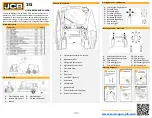
Checking the Spark Plugs
1.
Look at the center of both spark plugs (
). If
you see light brown or gray on the insulator, the engine
is operating properly. A black coating on the insulator
usually means that the air cleaner is dirty.
Important:
Never clean the spark plugs. Always
replace the spark plugs when they have a black
coating, worn electrodes, an oily film, or cracks.
Figure 41
1.
Center-electrode insulator
3.
Air gap (not to scale)
2.
Side electrode
2.
Check the gap between the center and side electrodes
(
).
3.
Bend the side electrode (
) if the gap is not
correct.
Installing the Spark Plugs
1.
Thread the spark plugs into the spark plug holes.
2.
Tighten the spark plugs to 27 N∙m (20 ft-lb).
3.
Push the wires onto the spark plugs (
4.
Close the hood.
Fuel System
Maintenance
Changing the Fuel Filter
Service Interval:
Every 200 hours/Yearly (whichever comes
first)
1.
Lower the loader arms, shut off the engine, and remove
the key.
2.
Open the hood and remove the left side screen.
3.
Loosen the tank cap to relieve pressure.
4.
Clamp the fuel lines on both sides of the fuel filter
(
).
Figure 42
1.
Filter
2.
Hose clamp
5.
Squeeze the ends of the hose clamps together and slide
them away from the filter (
6.
Place a drain pan under the fuel lines to catch any leaks,
then remove the filter from the fuel lines.
7.
Slide the fuel lines on the new fuel filter fittings,
ensuring that the arrow on the filter points away from
the fuel line coming from the fuel tank and toward the
line going to the fuel pump.
Important:
Never install a dirty filter.
8.
Move the hose clamps close to the filter.
9.
Remove the clamp blocking fuel flow and open the
fuel valves.
10.
Secure the tank cap.
11.
Replace the side screen and close the hood.
32
Содержание TX 427 22342HD
Страница 49: ...Schematics g013124 Electrical Schematic Rev B 49...
Страница 50: ...Hydraulic Schematic Rev A 50...
Страница 51: ...Notes...



































